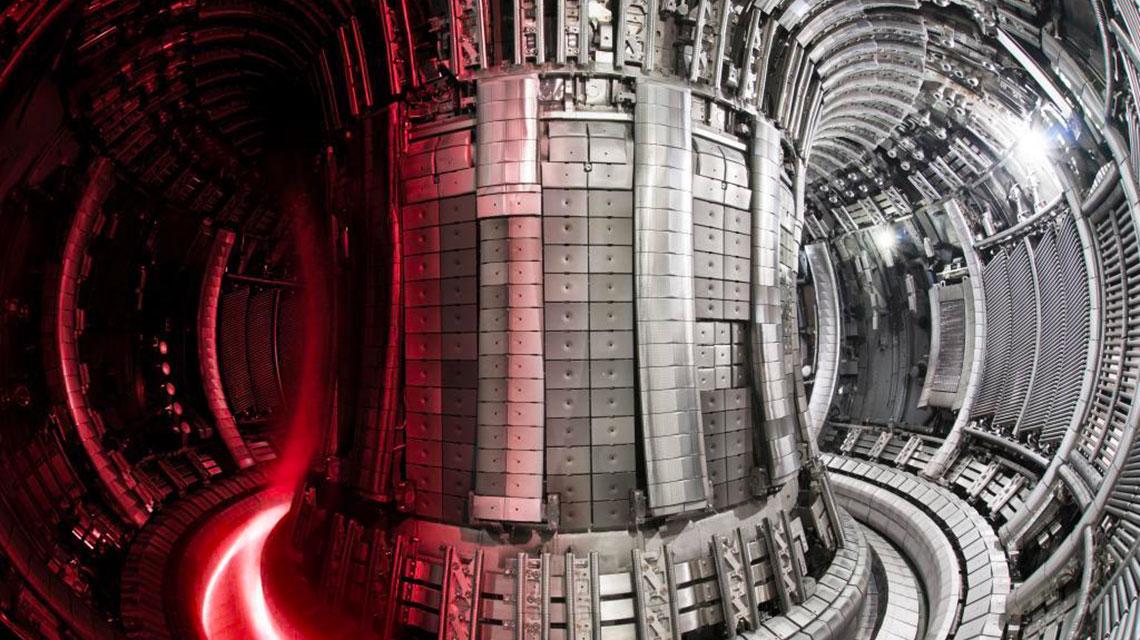Italian National Agency for New Technologies, Energy and Sustainable Economic Development

Energy: European researchers achieve fusion energy record
Researchers from the EUROfusion consortium achieved record-breaking 59 megajoules of sustained fusion energy at world-leading Joint European Torus (JET), the largest and most powerful operational tokamak in the world at the UK Atomic Energy Authority (UKAEA) site in Culham, Oxfordshire (UK).
This achievement on JET more than doubles the previous fusion energy record of 21.7 megajoules set there in 1997. It comes as part of a dedicated experimental campaign designed by EUROfusion to test over two decades’ worth of advances in fusion and optimally prepare for the start of the international ITER project.
The record and the scientific data from these crucial experiments are a major boost for ITER, the larger and more advanced version of JET. ITER is a fusion research project based in the south of France. Supported by seven members – China, the European Union, India, Japan, South Korea, Russia and the USA – ITER aims to demonstrate the scientific and technological feasibility of fusion energy.
As pressures mount to address the effects of climate change through decarbonising energy production, this success is a major step forward on fusion’s roadmap as a safe, efficient, low carbon means of tackling the global energy crisis.
The EUROfusion Consortium is co-funded by the European Commission and comprises 4800 scientists from 30 member institutes and 152 associated entities from 28 European countries (25 EU countries, United Kingdom, Switzerland and Ukraine).
"The Italian fusion research network, which counts over twenty partners and is coordinated by ENEA, successfully contributes to the EUROfusion Consortium in terms of scientific and technological development, and represents a case of success in terms of technology transfer to the national production system with significant beneficial economic effects”, pointed out Paola Batistoni, head of the ENEA Fusion Energy Development and Promotion Section.
EUROfusion has recently signed its second Grant Agreement with a budget of over 1 billion euro to develop fusion energy over the years 2021-2025. The grant includes a European contribution of over 550 million euro as part of the new Horizon Europe research framework program with which EUROfusion will coordinate the research program described in the 'European Roadmap for fusion energy'. Italy, the second most important partner of the Consortium after Germany, will be allocated 16% of the European contribution, approximately 90 million euro.
In the coming years, Italy will play a key role in Europe with the new DTT (DIVERTOR TOKAMAK TEST facility), under construction at the ENEA Frascati Research Center thanks to a consortium comprising ENEA, ENI and various institutes and universities. As part of the European Roadmap, DTT will investigate alternative power exhaust solutions for the demonstration fusion reactor. Italy has committed, in agreement with its partners and with a European contribution, to build this facility for a total investment of about 600 million euro. DTT is an important growth opportunity for Italian research and will make the most of the expertise gained in the program by industry and research.
Gilberto Dialuce, President of ENEA, said: "The outcome achieved by JET confirms and reinforces our commitment to the project ITER and to the development of fusion energy as part of a joint European effort. We are especially proud of our researchers, who designed and conducted the experiments and performed the data analysis. They also coordinated the European team that studied the technological exploitation of deuterium-tritium operations, crucial for the project ITER under construction in France. This follows on in a long-standing tradition ENEA has of being among the major and most qualified contributors to JET since its beginning, with scientists holding leadership positions in research and management in the entire project ".
Alessandro Dodaro, Program Manager of the Italian Research Group within Eurofusion and Head of the ENEA Fusion and Technologies for Nuclear Safety Department, said: "As a representative of the Italian team I have the honor to coordinate in the European fusion program, it is with great emotion that I congratulate you on the very important result accomplished by JET. This achievement will persuade even the most skeptical that sharing skills and resources has shortened the path leading to fusion as an energy source."
Francesco Romanelli (ENEA), Director of JET from 2006 to 2013, currently President of the DTT Consortium, said: "The outcome of the JET DT campaign is the culmination of decades of experience and proof of how Europe, working together, is capable of delivering on objectives at the frontier of scientific and technological knowledge. The JET data bodes well for ITER and will enable us to move faster towards the goal of fusion energy production. The JET experiment was the closest we could get to achieving the conditions we will study on ITER and has crucially contributed to train a new generation of young researchers."
Dr Bernard Bigot, Director General of ITER, said: “A sustained pulse of deuterium-tritium fusion at this power level – nearly industrial scale – delivers a resounding confirmation to all of those involved in the global fusion quest. For the ITER Project, the JET results are a strong confidence builder that we are on the right track as we move forward toward demonstrating full fusion power.”
Prof Tony Donné, EUROfusion Programme Manager (CEO), said:“This achievement is the result of years-long preparation by the EUROfusion team of researchers across Europe. The record, and more importantly the things we’ve learned about fusion under these conditions and how it fully confirms our predictions, show that we are on the right path to a future world of fusion energy. If we can maintain fusion for five seconds, we can do it for five minutes and then five hours as we scale up our operations in future machines. This is a big moment for every one of us and the entire fusion community. Crucially, the operational experience we’ve gained under realistic conditions gives us great confidence for the next stage of experiments at ITER and Europe’s demonstration power plant EU DEMO, which is being designed to put electricity on the grid.”
Prof Ian Chapman, UKAEA’s CEO, added:“These landmark results have taken us a huge step closer to conquering one of the biggest scientific and engineering challenges of them all. It is reward for over 20 years of research and experiments with our partners from across Europe.It’s clear we must make significant changes to address the effects of climate change, and fusion offers so much potential. We’re building the knowledge and developing the new technology required to deliver a low-carbon, sustainable source of baseload energy that helps protect the planet for future generations. Our world needs fusion energy.”
Fusion energy’s potential
Fusion, the process that powers stars like our sun, promises a near-limitless clean electricity source for the long term, using small amounts of fuel that can be sourced worldwide from inexpensive materials. The fusion process brings together atoms of light elements like hydrogen at high temperatures to form helium and release tremendous energy as heat. Fusion is inherently safe in that it cannot start a run-away process.
JET of unique importance
The Joint European Torus (JET) fusion experiment – which can create plasmas reaching temperatures of 150 million degrees Celsius, 10 times hotter than the centre of the sun – is a vital test bed for ITER, one of the biggest collaborative science projects in history. JET can reach conditions similar to those in ITER and future fusion power plants, and is the only operational tokamak in the world that can use the same deuterium-tritium (D-T) fuel mix planned for those devices.
A European undertaking
JET was built and operated in Culham, UK, as a Joint Undertaking of the European Community since 1977. The facility has been operated by the UKAEA from 2000. The Euratom Research and Training programme has continuously contributed approx. 80% of the JET operation costs from 1977 until the end of 2021.
Megajoules and Megawatts explained
In its recent record-breaking experiment, JET produced a total of 59 Megajoules of heat energy from fusion over a five second period (the duration of the fusion experiment). During this experiment, JET averaged a fusion power (i.e., energy per second) of around 11 megawatts (megajoules per second).
The previous energy record from a fusion experiment, achieved by JET in 1997, was 22 megajoules of heat energy. The peak power of 16MW achieved briefly in 1997 has not been surpassed in recent experiments, as the focus has been on sustained fusion energy.
About Fusion
Fusion research aims to copy the process that powers the sun for a new large-scale source of low-carbon energy here on earth.
When light atoms fuse together to form heavier ones, a large amount of energy is released. To do this, a few grams of hydrogen fuels are heated to extreme temperatures, 10 times hotter than the centre of the sun, forming a plasma in which fusion reactions take place. A commercial fusion power station would use the energy produced by fusion reactions to generate electricity.
Fusion has huge potential as a low-carbon energy source. It is environmentally responsible and safe, using fuel that is abundant and sustainable. Pound for pound it releases nearly ten million times more energy than burning coal, oil or gas.
About EUROfusion
EUROfusion is a consortium of 30 research organisations, and behind them around 150 affiliated entities including universities and companies, from 25 European Union member states plus the United Kingdom, Switzerland and Ukraine. Together they work towards a facility that can deliver fusion electricity to the power grid in accordance with the European Research Roadmap to the Realisation of Fusion Energy.
The EUROfusion programme has two aims: preparing for ITER experiments and developing concepts for the future European demonstration fusion power plant EU DEMO. Another facet of the EUROfusion programme is to support diverse research projects in participating laboratories through the Enabling Research scheme.
For more information: https://www.euro-fusion.org/, LinkedIn, Twitter #road2fusion
About UKAEA
The UK Atomic Energy Authority (UKAEA) carries out fusion energy research on behalf of the UK Government. UKAEA oversees the UK’s fusion programme, headed by the MAST Upgrade (Mega Amp Spherical Tokamak) experiment. It also hosts the world’s largest fusion research facility, JET (Joint European Torus), which it operates for scientists from around Europe.
More information: https://www.gov.uk/ukaea. Social Media: @UKAEAofficial
About ITER
ITER—designed to demonstrate the scientific and technological feasibility of fusion power—will be the world's largest experimental fusion facility. ITER is also a first-of-a-kind global collaboration.
Europe is contributing almost half of the costs of its construction, while the other six Members to this joint international venture (China, India, Japan, the Republic of Korea, the Russian Federation and the USA), are contributing equally to the rest.
The ITER Project is under construction in Saint-Paul-lez-Durance, in the south of France.
For more information: http://www.iter.org/
About Euratom
The Euratom Research and Training Programme (2021-2025) is a nuclear research and training programme with an emphasis on the continuous improvement of nuclear safety, security and radiation protection and fusion energy research. It complements the achievement of Horizon Europe’s objectives including in the context of the energy transition as well as contributing to the implementation of the European fusion roadmap.
